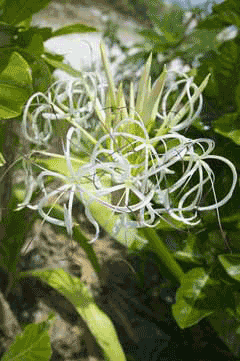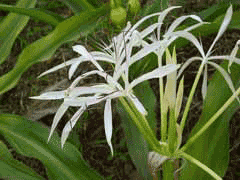 |
|
http://commons.wikimedia.org/wiki/User:Epibase |
 |
| http://commons.wikimedia.org/wiki/User:Cychk |
Translate this page:
Summary
Physical Characteristics

 Crinum asiaticum is a BULB growing to 1.2 m (4ft).
Crinum asiaticum is a BULB growing to 1.2 m (4ft).
See above for USDA hardiness. It is hardy to UK zone 8. It is in flower from June to August. The species is hermaphrodite (has both male and female organs) and is pollinated by Insects.
Suitable for: light (sandy), medium (loamy) and heavy (clay) soils and prefers well-drained soil. Suitable pH: mildly acid, neutral and basic (mildly alkaline) soils. It cannot grow in the shade. It prefers moist soil.
UK Hardiness Map
US Hardiness Map
Synonyms
Plant Habitats
Cultivated Beds;
Edible Uses
References More on Edible Uses
Medicinal Uses
Plants For A Future can not take any responsibility for any adverse effects from the use of plants. Always seek advice from a professional before using a plant medicinally.
Emetic Poultice
The bulb contains alkaloids, notably lycorine and crinamine[283]. A poultice made from the heated, pounded, fresh bulb is used to relieve osteodynia and rheumatism[283]. The juice of the fresh bulb is used as an emetic, whilst it is also instilled in the ear to treat otis[283]. A poultice of the heated, pounded, fresh leaves is used to treat contusions, sprains, fractures, luxations etc[283]. A decoction of the dried leaves is used as a wash in the treatment of haemorrhoids[283].
References More on Medicinal Uses
The Bookshop: Edible Plant Books
Our Latest books on Perennial Plants For Food Forests and Permaculture Gardens in paperback or digital formats.

Edible Tropical Plants
Food Forest Plants for Hotter Conditions: 250+ Plants For Tropical Food Forests & Permaculture Gardens.
More

Edible Temperate Plants
Plants for Your Food Forest: 500 Plants for Temperate Food Forests & Permaculture Gardens.
More

More Books
PFAF have eight books available in paperback and digital formats. Browse the shop for more information.
Shop Now
Other Uses
References More on Other Uses
Cultivation details
Prefers a deep, well-drained but moisture-retentive fertile soil that is rich in organic matter[200]. The bulbs must have sufficient moisture during the growing season[200]. Plants are not very cold hardy, tolerating occasional lows down to about -5°c[200]. In regions at the limits of their cold hardiness, they are best given the protection of a south or southwest facing wall. Plant the bulbs shallowly, with the neck of the bulb at soil level, and give a protective mulch of bracken or compost in the winter[200]. A robust and very variable species[270]. Bulbs are sensitive to transplanting and can take several years to become established. After this, they will usually reproduce rapidly from offsets to produce the overcrowded conditions that stimulate them to flower freely[200].
References Carbon Farming Information and Carbon Sequestration Information
Temperature Converter
Type a value in the Celsius field to convert the value to Fahrenheit:
Fahrenheit:
The PFAF Bookshop
Plants For A Future have a number of books available in paperback and digital form. Book titles include Edible Plants, Edible Perennials, Edible Trees,Edible Shrubs, Woodland Gardening, and Temperate Food Forest Plants. Our new book is Food Forest Plants For Hotter Conditions (Tropical and Sub-Tropical).
Shop Now
Plant Propagation
Seed - best sown as soon as it is ripe, placing 2 - 3 seeds in individual pots in a greenhouse. Do not cover the seed. Sow stored seed April/May in a warm greenhouse. Once they have germinated, you can thin each pot to just one plant if required, though we have not found this to be necessary. Give an occasional liquid feed to ensure that the plants do not suffer nutritional deficiencies. Grow them on in the greenhouse for at least their first 2 years, planting them out into their permanent positions in the spring. Division of offsets in April/May or in September. When divided in the spring, the bulbs can be planted out direct into their permanent positions, if done in September, however, they should be potted up and overwintered in the greenhouse.
Other Names
If available other names are mentioned here
Native Range
TEMPERATE ASIA: China (Fujian Sheng, Guangdong Sheng, Guangxi Zhuangzu Zizhiqu), Taiwan TROPICAL ASIA: India, Sri Lanka, Papua New Guinea, Cambodia, Laos, Myanmar, Thailand, Vietnam, Brunei Darussalam, Indonesia (Jawa), Malaysia, Philippines, Singapore PACIFIC: Marshall Islands, United States (Guam), Fiji, New Caledonia, Samoa AUSTRALASIA: Australia (Northern Territory) AFRICA: Mauritius
Weed Potential
Right plant wrong place. We are currently updating this section.
Please note that a plant may be invasive in one area but may not in your area so it's worth checking.
Conservation Status
IUCN Red List of Threatened Plants Status :

Growth: S = slow M = medium F = fast. Soil: L = light (sandy) M = medium H = heavy (clay). pH: A = acid N = neutral B = basic (alkaline). Shade: F = full shade S = semi-shade N = no shade. Moisture: D = dry M = Moist We = wet Wa = water.
Now available:
Food Forest Plants for Mediterranean Conditions
350+ Perennial Plants For Mediterranean and Drier Food Forests and Permaculture Gardens.
[Paperback and eBook]
This is the third in Plants For A Future's series of plant guides for food forests tailored to
specific climate zones. Following volumes on temperate and tropical ecosystems, this book focuses
on species suited to Mediterranean conditions—regions with hot, dry summers and cool, wet winters,
often facing the added challenge of climate change.
Read More
Expert comment
Author
L.
Botanical References
200
Links / References
For a list of references used on this page please go here
Readers comment